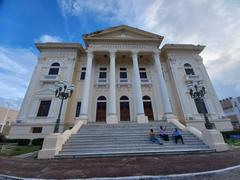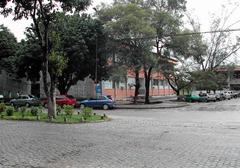Fort of São João de Maceió: Visiting Hours, Tickets, and Historical Sites in Maceió
Date: 04/07/2025
Introduction
Nestled on Brazil’s picturesque northeastern coast, the Fort of São João de Maceió stands as a prominent emblem of the region’s colonial past and architectural ingenuity. Established between the 16th and 17th centuries, this fortification was integral to Portugal’s defensive network, protecting Maceió’s crucial port and adjacent territories from European rivals and maritime threats. Its star-shaped design—an enduring legacy of Renaissance military architecture—demonstrates the fusion of European expertise and local adaptation that characterizes Brazil’s colonial forts. Today, the fort provides visitors with immersive insights into Brazil’s coastal defense strategies, Maceió’s heritage, and panoramic views of the Atlantic and Mundaú Lagoon. This comprehensive guide covers everything you need to plan your visit, including hours, ticketing, accessibility, tours, and nearby attractions (UNESCO Tentative List, Wikivoyage, Visit Brasil).
Table of Contents
- Historical Context of Colonial Fortifications in Brazil
- Strategic Significance of Fort São João de Maceió
- Architectural Features and Conservation
- Community Identity and Cultural Role
- Visiting Information: Hours, Tickets, and Accessibility
- Visitor Experience and Nearby Attractions
- Practical Tips and Safety
- Frequently Asked Questions (FAQ)
- Conclusion and Further Resources
Historical Context of Colonial Fortifications in Brazil
From the 16th through the 19th century, Brazil was embroiled in territorial disputes and faced constant threats from European adversaries such as the Dutch, French, English, and Spanish. In response, the Portuguese established a network of coastal and inland forts, each tailored to local threats and resources. This decentralized approach resulted in a rich diversity of fortifications, blending European Renaissance and Baroque military principles with regional materials and techniques (UNESCO Tentative List).
Strategic Significance of the Fort
The Fort of São João de Maceió played a pivotal defensive role in the region. Its placement near the mouth of the Mundaú Lagoon allowed for surveillance of maritime activity and protection of the city’s economically vital port. The fort helped repel foreign incursions, particularly during the Dutch occupation of northeastern Brazil, and supported the growth of Maceió as a strategic and economic hub (UNESCO Tentative List).
Architectural Features and Conservation
Design and Construction
The fort exemplifies Portuguese colonial military architecture, with a star-shaped layout, thick curtain walls, angular bastions, and strategic vantage points. Built from local stone and lime mortar, it incorporates:
- Bastions and Ramparts: Project outward for crossfire coverage and artillery positioning.
- Curtain Walls: Sloped and robust to absorb cannon fire.
- Interior Structures: Barracks, powder magazines, storerooms, and command posts.
- Gatehouse: Originally equipped with a drawbridge and defensive towers (Wikipedia).
Conservation Efforts
Ongoing preservation efforts use authentic materials and modern monitoring to stabilize masonry, repair weathered stone, and maintain the original layout. Accessibility upgrades—such as ramps and interpretive signage—strive to balance visitor experience with heritage protection (Total Military Insight).
Community Identity and Cultural Role
The fort is more than a military relic; it’s a symbol of resilience and a cornerstone of Maceió’s identity. It hosts cultural events, educational programs, and public gatherings, especially during the São João Festival, which features traditional music, dance, and food (Tropicalis). Local schools use the site for history lessons and heritage awareness, while ongoing research partnerships with universities further its educational mission.
Visiting Information: Hours, Tickets, and Accessibility
- Visiting Hours: Open Tuesday to Sunday, 9:00 AM–5:00 PM. Closed on Mondays for maintenance. Confirm hours during holidays or events (Visit Brasil).
- Tickets: Admission typically ranges from R$5–R$15 (about $1–$3 USD). Discounts are available for students, seniors, and children; children under 6 enter free. Guided tours may incur an additional charge.
- Accessibility: Main entrance and exhibition spaces are wheelchair accessible, but some historic areas (ramparts, upper levels) require stair access. Contact the site ahead for assistance.
Visitor Amenities
Facilities include restrooms, shaded seating, bilingual information panels, and a small café/kiosk. Photography is allowed in most areas, though flash/tripods may be restricted.
Visitor Experience and Nearby Attractions
Explore the fort’s ramparts, bastions, and interior structures, enhanced by interpretive panels and guided tours. Plan to combine your visit with:
- Museu do Comércio de Alagoas: Showcasing regional commercial history.
- Praia de Pajuçara and Praia de Ponta Verde: Beautiful beaches for relaxation.
- Jaraguá Historic District: Offers colonial architecture, markets, and cultural events.
- Central Market: For handicrafts and local foods (Tourist Maker).
During the São João Festival (June–August), the fort becomes a hub for concerts and folk celebrations (Maceió Dicas, Mercado e Eventos).
Practical Tips and Safety
- Transport: Use taxis or ride-sharing apps for convenience and security, especially if unfamiliar with the city (I Heart Brazil).
- Dress and Weather: Wear lightweight clothes and sturdy shoes; bring sun protection and water.
- Safety: Remain vigilant in less-crowded areas and after dark. Secure valuables and avoid carrying large sums of cash (Caroline Rose Travel).
- Language: Portuguese is predominant; a translation app can enhance your experience.
- Payments: Carry some cash; most places accept cards.
- Emergency Numbers: Police: 190, Ambulance: 192.
Frequently Asked Questions (FAQ)
Q: What are the fort’s opening hours?
A: Tuesday to Sunday, 9:00 AM–5:00 PM. Confirm during holidays or special events.
Q: How much are tickets?
A: R$5–R$15, with discounts for students, seniors, and children.
Q: Are guided tours available?
A: Yes, often in Portuguese; some English resources are available. Tours may be booked onsite or in advance.
Q: Is the fort accessible for those with disabilities?
A: Main entrances and some exhibitions are accessible, but ramparts and upper levels require stairs.
Q: Can I take photographs?
A: Yes, except where signage restricts due to preservation concerns.
Q: What’s the best way to get there?
A: Private transport (taxi, Uber) is recommended for safety and convenience.
Conclusion and Further Resources
The Fort of São João de Maceió is a testament to Brazil’s colonial past, architectural innovation, and enduring cultural spirit. With accessible visiting hours, affordable tickets, and integration into Maceió’s vibrant cultural scene, it is an essential stop for history lovers and casual travelers alike.
For the latest visitor information and updates, download the Audiala app, explore related articles on our platform, and follow us on social media. Plan your journey to experience the stories and sights that shaped Maceió.
Visuals and Interactive Media
- High-resolution images of the fort’s bastions, panoramic lagoon views, and educational displays (with alt tags like “Fort of São João de Maceió visiting hours”).
- Interactive maps and virtual tours (when available).
Internal Links
External and Authoritative References
- UNESCO Tentative List on Brazilian Fortifications
- Maceió São João Festival Details
- Mercado e Eventos - Cultural Events in Maceió
- Official Maceió Tourism Website
- Fort of São João de Maceió - Local Heritage Organization
- I Heart Brazil
- Tourist Maker
- Caroline Rose Travel
- Tropicalis
- Total Military Insight


